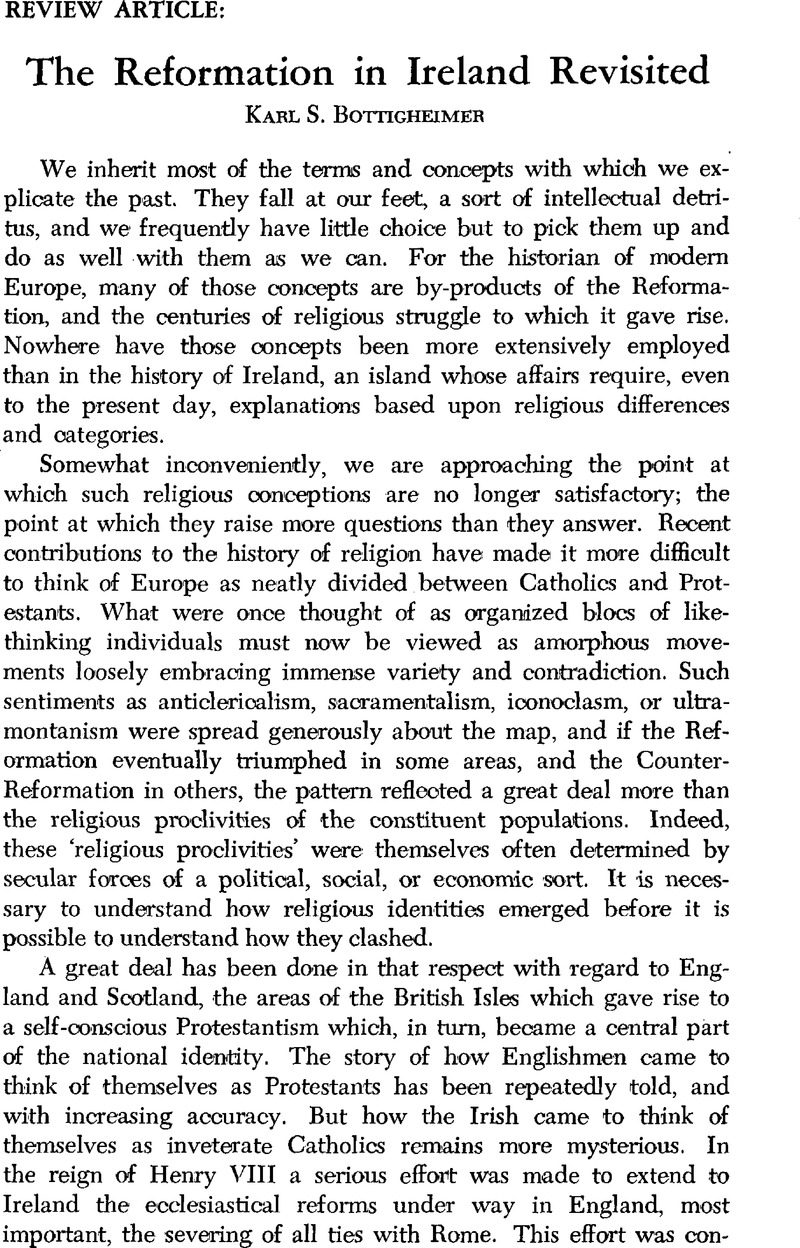No CrossRef data available.
Article contents
The Reformation in Ireland Revisited
Published online by Cambridge University Press: 16 January 2014
Abstract

- Type
- Review Article
- Information
- Copyright
- Copyright © North American Conference of British Studies 1976
References
1. For a Catholic example, see Edwards, R. Dudley, Church and State in Tudor Ireland (Dublin, 1935)Google Scholar; for a Protestant one, Jourdan's, G. V. chapters in The Histtory of the Church of Ireland, ed. Philips, W. A. (Oxford, 1934), Vol. IIGoogle Scholar.
2. Cambridge University Press, 1974.
3. An invaluable preliminary, however, was Gwynn, A. and Hadcock, R. N. (eds.), Medieval Religious Houses in Ireland (London, 1970)Google Scholar. Bradshaw justly gives generous credit to this meticulous and scholarly catalogue of the Irish Houses.
4. “The Counter-Reformation and the People of Catholic Ireland, 1596-1641,” Historical Studies, VIII (Dublin, 1971), 157Google Scholar.
5. Bradshaw, , The Dissolution of the Religious Orders in Ireland under Henry VIII, (hereafter cited as Bradshaw), p. 35Google Scholar.
6. Ibid., p. 8. This interpretation is set forth by Martin, F. X. in “The Irish Augustinian Reform of the 15th Century,” Medieval Studies, Watt, J.et al. eds. (Dublin, 1961)Google Scholar; and “The Observant Movement in Ireland”, Irish Catholic History Committee Proceedings, 1960Google Scholar.
7. Bradshaw, p. 38.
8. Ibid., p. 40.
9. Ibid., p. 49.
10. Ibid.
11. Ibid., p. 53.
12. Ibid., p. 59.
13. “The Opposition to the Ecclesiastical Legislation in the Irish Reformation Parliament,” Irish Historical Studies, XVI (1968–1969), 296Google Scholar.
14. Bradshaw, p. 74.
15. Ibid., pp. 100-04.
16. Ibid., p. 106. For purposes of comparison the author reminds us that the single Chapel of St. Swithin in Winchester yielded the English confiscators 2000 marks in treasure.
17. The Annals of Loch Cé, ed. Hennessy, W. M. (London, 1871), II, 314Google Scholar are given as a case in point. Bradshaw, p. 106
18. Ibid., p. 126.
19. Ibid., p. 131.
20. Ibid., p. 160.
21. Ibid., p. 162.
22. Ibid., p. 180.
23. Ibid., p. 187.
24. Ibid.
25. Ibid., p. 190.
26. Ibid., p. 206.
27. Ibid., p. 208.
28. Ibid., p. 216.
29. Ibid., p. 94.
30. It will be published in the series, Studies in Irish History. I am indebted to the author for his kind permission to read an earlier draft. See also his “George Browne, First Reformation Archbishop of Dublin, 1536-1554,” Journal of Ecclesiastical History, Vol. XXI (1970)Google Scholar, and “The Beginnings of Modern Ireland” in The Irish Parliamentary Tradition, ed. Farrell, Brian (Dublin, 1973)Google Scholar.
31. See The Old English in Ireland, 1625-42 (London, 1966)Google Scholar.
32. “The Ideology of English Colonization from Ireland to America”, William and Mary Quarterly, 3rd Series, Vol. XXX (1973)Google Scholar. See also Dr.Canny's, “Glory and Gain: Sir Henry Sidney and the Government of Ireland, 1558-1578”, (Ph. D. thesis, University of Pennsylvania, 1971)Google Scholar.
33. “Ireland and 16th Century Expansion,” Historical Studies, I (London, 1958)Google Scholar.
34. Valuable recent work on these questions includes: Hammerstein, Helga, “Aspects of the Continental Education of Irish Students in the Reign of Elizabeth I,” Historical Studies, VIII (Dublin, 1971)Google Scholar; Kearney, H.F., “Ecclesiastical Politics and the Counter-Reformation in Ireland, 1618-1648,” Journal of Ecclesiastical History, XI (1960)Google Scholar. For the rise of English ‘Catholophohia’ see Wiener, Carol Z., “The Beleaguered Island,” Past and Present, No. 51 (May 1971)Google Scholar, and Robin Clifton, “The Popular Fear of Catholics during the English Revolution,” ibid., No. 52 (Aug., 1971); Hill, Christopher, Antichrist in Seventeenth-Century England (London, 1971)Google Scholar; and Maltby, William S., The Black Legend: Anti-Spanish Sentiment in England, 1558-1660 (Durham, N.C., 1971)Google Scholar.




